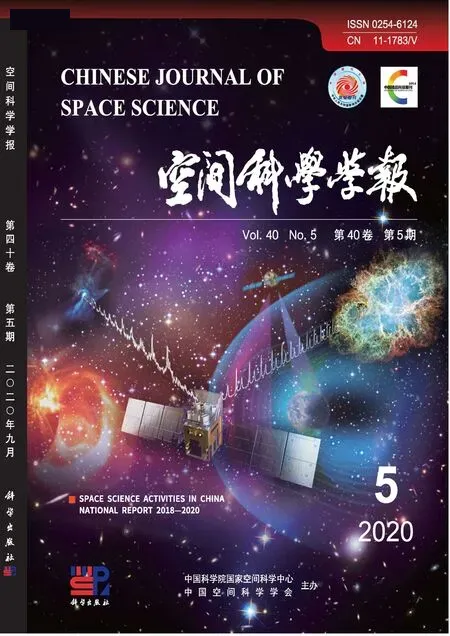Progress on SVOM Satellite Development
WEI Jianyan
Progress on SVOM Satellite Development
WEI Jianyan
(100101)
SVOM (Space-based multiband astronomical Variable Objects Monitor) is a Chinese-French space mission dedicated to studying Gamma-Ray Bursts. The satellite has four instruments to detect and localize the prompt GRB emission and measure the evolution of the afterglow in the visible band and in X-rays, and a VHF communication system enabling the fast transmission of SVOM alerts to the ground. The ground segment includes an array of wide-angle cameras and two follow-up telescopes. It was planned to be in orbit in 2021, and now has to be delayed about six months because of COVID-19 epidemic.
Space astronomy, Gamma-ray burst
SVOM (Space-based multiband astronomical Variable Objects Monitor) is a mission dedicated to studying Gamma-Ray Bursts (GRBs)[1]. The mission has been approved jointly by both Chinese and French space agencies. The satellite will have an orbit with an altitude of 600~650 km and an inclination of 29°. The system Critical Definition Review (CDR) was carried out by CNSA and CNES in July 2020. It was planned to be in orbit in 2021, and now has to be delayed about six months because of COVID-19 epidemic.
GRBs are extremely luminous transient sources appearing when a newborn stellar mass black hole or magnetar emits an ultra-relativistic jet towards the Earth. Consequently, the study of GRBs not only has the potential to expand or revolutionize our understanding of key astrophysical issues on the mechanisms driving stellar explosions and the radiation processes of relativistic jets. In the next years GRBs will also undoubtedly shed new light on the evolution of the young universe, particularly on the history of star formation, the metal enrichment of galaxies, and the reionization of the intergalactic medium[2]. GRB 170817A, a normal short GRB detected by Fermi-GBM, was the first confirmed counterpart of gravitational-wave transients, which made GRBs even hotter topic[3].
The scientific objectives of SVOM put a special emphasis on two categories of GRBs: very distant GRBs at>5 which constitute exceptional cosmological probes, and faint/soft nearby GRBs which allow probing the nature of the progenitors and the physics at work in the explosion. These goals have a major impact on the design of the mission: the on-board hard X-ray imager is sensitive down to 4 keV and computes online image and rate triggers, and the follow-up telescopes on the ground are sensitive in the NIR.
In order to take advantage of the astrophysical potential of GRBs, SVOM is designed to (i) permit the detection of all known types of GRBs; (ii) provide fast, reliable GRB positions; (iii) measure the spectral shape of the GRB prompt emission from visible to MeV; (iv) measure the temporal properties of the GRB prompt emission from visible to MeV; (v) identify quickly the afterglows of detected GRBs at both X-ray and visible bands, including the ones that are highly redshifted (>5); (vi) measure the spectral shape of the early and late GRB afterglow from visible to X-rays; (vii) measure the temporal evolution of the early and late GRB afterglow from visible to X-rays.
SVOM mission is designed to consist of a set of scientific instruments to implement the synergy bet-ween space and ground observations. The space-based instruments include: (i) ECLAIRs, a wide field-of- view hard X-ray imager and spectrometer; (ii) GRM, a wide field-of-view soft gamma-ray spectrometer; (iii) MXT, a narrow field-of-view low-energy X-ray telescope; (iv) VT, a narrow field-of-view visible/near infrared (NIR) telescope. An artist view of the SVOM satellite is showed in Figure1. And the ground-based instruments include: (i) GFTs, two follow-up telescopes (one of which featu-ring efficient NIR capabilities); (ii) GWAC, an array of wide field-of-view cameras in visible band.
At the beginning of the next decade, SVOM will be the main provider of GRB positions and spectral parameters. The SVOM instrumentation, primarily designed for GRB studies, composes a unique multi-wavelength observatory with rapid slew capability and quick command up-link capability. Therefore, SVOM will also be a powerful target-of-opportunity observatory for the whole astronomy community beyond the specific objectives linked to GRBs. For example, the SVOM mission has been conceived to promptly point to the celestial fields where sources have been detected by wide field of view astronomical devices such as the upgraded generation of gravitational wave detectors (advanced Virgo/LIGO) and high-energy neutrino detectors (IceCube, KM3NeT).

Fig.1 Artist view of the SVOM satellite
[1] WEI J, CORDIER B, ANTIER S,. The deep and transient universe in the SVOM era: new challenges and opportunities–scientific prospects of the SVOM mission [J]. arXiv161006892W, 2016
[2] GEHRELS N, RAMIREZ-RUIZ E, FOX D B. Gamma-ray bursts in the swift era [J].., 2009, 47(1):567-617
[3] GOLDSTEIN A, VERES P, BURNS E,. An ordinary short gamma-ray burst with extraordinary implications: fermi-GBM detection of GRB 170817A [J].., 2017, 848(2):14
V474
WEI Jianyan. Progress on SVOM Satellite Development., 2020, 40(5): 698-699. DOI:10.11728/cjss2020.05.698
July 28, 2020
E-mail: wjy@nao.cas.cn
- 空間科學(xué)學(xué)報的其它文章
- Space Solar Physics in China*
- Space Materials Science in China: I. Experiment Studies under Microgravity*
- Space Life Science of China*
- Advances in the Researches of the Middle and Upper Atmosphere in China
- Magnetospheric Physics in China*
- Status of the Advanced Space-based Solar Observatory*

